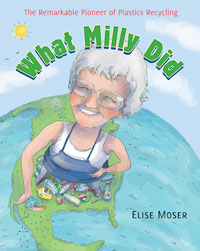| ________________
CM . . .
. Volume XXIV Number 35. . . .May 11, 2018

 |
What Milly Did: The Remarkable Pioneer of Plastics Recycling.
Elise Moser. Pictures by Scot Ritchie.
Toronto, ON: Groundwood, 2016.
48 pp., pbk., html & mobi, $11.95 (pbk.).
ISBN 978-1-55498-893-8 (pbk.), ISBN 978-1-55498-894-5 (html), ISBN 978-1-55498-895-2 (mobi).
Subject Headings:
Zantow, Milly-Juvenile literature.
Recycling (Waste, etc.)-Juvenile literature.
Green movement-Juvenile literature.
Environmentalism-Juvenile literature.
Grades 2-5 / Ages 7-10.
Review by Tanya Boudreau.
*** /4
|
| |
|

excerpt:
Back on the farm, they didn’t have money to spend. In those days credit cards didn’t exist- cash was the only money. The only cash income for Milly’s whole family came from selling their cows’ cream, which meant they had to produce almost everything they needed. They grew a lot of their own food. Milly’s grandmother made bread for the large family every single day, baking it in the wood-burning oven. They kept chickens, and in the winter it was little Milly who had to collect the eggs from the henhouse before they froze.
Milly’s family fixed anything that broke instead of throwing it away, because they couldn’t afford to buy anything new. When her dad’s overalls were so worn out that they couldn’t be mended anymore, Milly’s mom found a few spots that were still whole to make mittens for the girls. Can you imagine going to school wearing mittens sewn from your dad’s old overalls?
Elise Moser has written an inspiring nonfiction children’s book about Milly Zantow (1923-2014), an environmentalist who made her passion for plastic recycling her life’s work. The timeline of the book follows Milly from a child to an adult. In her early years, Milly, out of necessity, learned how to recycle material from her family. As she grew older and traveled away from her family, she learned about recycling from people in Japan. She was so impressed with their clean, non-wasteful communities, she took steps to make separating garbage possible in her community in Wisconsin.
The timeline of her life includes her partnership with a friend Jenny. They formed E-Z Recycling. Once plastic recycling was established in her town (and it started with teachers and students and hiring people who often didn't get hired for jobs), she went to other communities to help them start a similar system. The author explains Milly’s goals (which were not money orientated) and how she used research, education, and communication to turn her passion into reality, a passion which continued into her nineties and was living in a nursing home.
Via sidebars, the author includes interesting plastic themed stories (i.e. a bridge made of plastic) that complement Milly’s belief in recycling. Each section is two to four pages in length. The book contains a few cartoon-style black and white illustrations. A glossary, an extensive bibliography and index, and explanations about how Milly became involved with the triangle symbol associated with recycling can be found at the end of the book. What Millie Did is inspiring because its contents show how one person can make a difference to many. Her persistence will encourage children not to give up on their passions.
Recommended.
Tanya Boudreau is a librarian at the Cold Lake Public Library in Cold Lake, AB.

© CM Association
CC BY-NC-ND
Hosted by:
University of Manitoba
ISSN 1201-9364
|
This Creative Commons license allows you to download the review and share it with others as long as you credit the CM Association. You cannot change the review in any way or use it commercially.
Commercial use is available through a contract with the CM Association. This Creative Commons license allows publishers whose works are being reviewed to download and share said CM reviews provided you credit the CM Association. |
Next Review | Table of Contents for This Issue - May 11, 2018.
CM Home | Back Issues | Search | CM Archive | Profiles Archive
|
